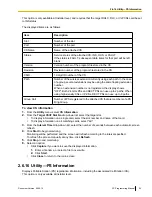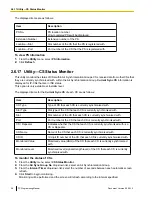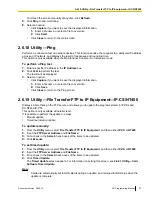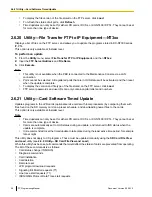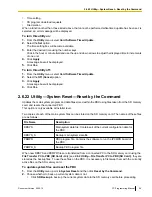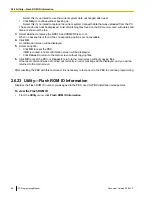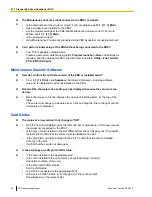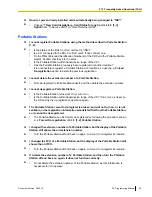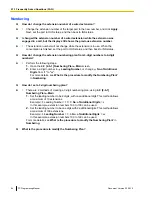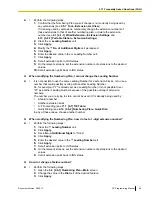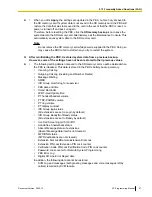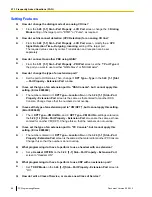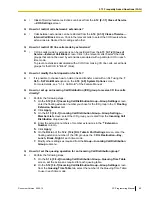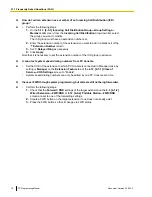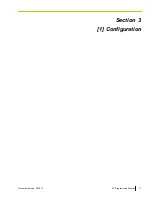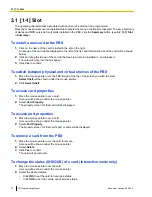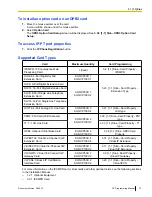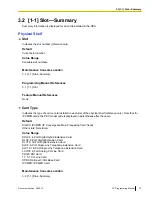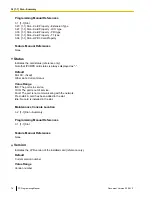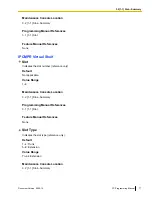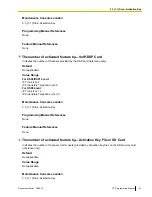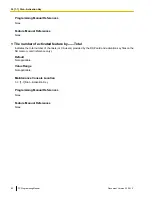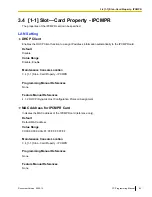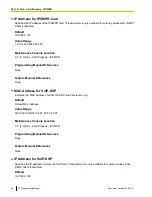
A
•
Class of Service feature restrictions can be set from the
Q
How do I restrict calls between 2 extensions?
A
•
Calls between extensions can be restricted from the
4.14 [2-7-3] Class of Service—
screen. Click in the relevant cells to select the COS levels whose
extensions are blocked from calling each other.
Q
How do I restrict CO line calls made by extensions?
A
•
CO line calls made by extensions can be restricted from the
screen. Click in the relevant cells to select the trunk
groups that cannot be used by extensions associated with a particular COS in each
time mode.
To prevent extensions associated with a COS from making CO line calls, set all trunk
groups for that COS to "Block" (blue).
Q
How do I modify the hold operation for SLTs?
A
•
It is possible to choose how to hold a line and transfer a call with an SLT using the
For more details, see "3.1.4 Call Hold" of the Feature Manual.
Q
How do I set up an Incoming Call Distribution (ICD) group to receive CO line calls
directly?
A
•
Perform the following steps:
1.
On the
5.12 [3-5-1] Incoming Call Distribution Group—Group Settings
screen,
enter the floating extension number you chose for the ICD group in the
2.
Click
Apply
.
3.
5.13 [3-5-1] Incoming Call Distribution Group—Group Settings—
screen, select the ICD group you created from the
Incoming Call
Distribution
drop-down list.
4.
Enter the extension numbers of member extensions in the
5.
Click
Apply
.
6.
12.2 [10-2] DIL Table & Port Settings
screen, enter the
floating extension number of the ICD group as the
7.
Modify other settings as required from the
Group—Incoming Call Distribution
Group
submenu.
Q
How do I set the queuing operation for an Incoming Call Distribution group?
A
•
Perform the following steps:
1.
5.14 [3-5-2] Incoming Call Distribution Group—Queuing Time Table
screen, set the actions as required for each queuing table.
2.
On the
5.12 [3-5-1] Incoming Call Distribution Group—Group Settings
screen,
tab, select the number of the Queuing Time Table
to use in each time mode.
Document Version 2009-12
PC Programming Manual
69
2.7.1 Frequently Asked Questions (FAQ)
Summary of Contents for KX-NCP500
Page 71: ...Section 3 1 Configuration Document Version 2009 12 PC Programming Manual 71 ...
Page 74: ... 3 4 1 Virtual Cards 74 PC Programming Manual Document Version 2009 12 3 1 1 1 Slot ...
Page 313: ...Section 4 2 System Document Version 2009 12 PC Programming Manual 313 ...
Page 450: ...450 PC Programming Manual Document Version 2009 12 4 21 2 11 2 Audio Gain Card ...
Page 451: ...Section 5 3 Group Document Version 2009 12 PC Programming Manual 451 ...
Page 533: ...Section 6 4 Extension Document Version 2009 12 PC Programming Manual 533 ...
Page 701: ...Section 7 5 Optional Device Document Version 2009 12 PC Programming Manual 701 ...
Page 731: ...Section 8 6 Feature Document Version 2009 12 PC Programming Manual 731 ...
Page 744: ...744 PC Programming Manual Document Version 2009 12 8 6 6 6 Tenant ...
Page 745: ...Section 9 7 TRS Document Version 2009 12 PC Programming Manual 745 ...
Page 753: ...Section 10 8 ARS Document Version 2009 12 PC Programming Manual 753 ...
Page 766: ...766 PC Programming Manual Document Version 2009 12 10 8 8 7 Authorization Code for TRG ...
Page 767: ...Section 11 9 Private Network Document Version 2009 12 PC Programming Manual 767 ...
Page 780: ...780 PC Programming Manual Document Version 2009 12 11 4 9 4 NDSS Key Table ...
Page 781: ...Section 12 10 CO Incoming Call Document Version 2009 12 PC Programming Manual 781 ...
Page 807: ...Section 13 11 Maintenance Document Version 2009 12 PC Programming Manual 807 ...
Page 847: ...Section 14 Appendix Document Version 2009 12 PC Programming Manual 847 ...

